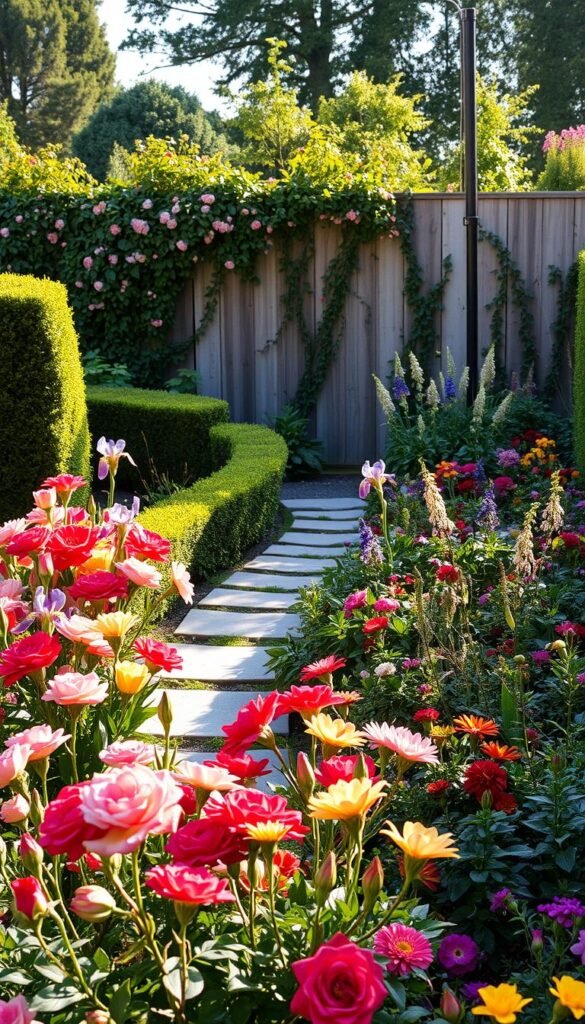Imagine stepping outside your door to a living canvas of blooms and foliage that dazzles in every season. Transforming your outdoor space into a four-season paradise isn’t just possible—it’s easier than you think. With smart plant choices and thoughtful design, you can replace ordinary grass with a thriving ecosystem that delights the senses and supports local pollinators.
Whether you’re a seasoned gardener or just starting out, creating year-round color centers on strategic layering. Combine early spring bulbs with summer perennials, autumn grasses, and winter-blooming shrubs for nonstop visual drama. Structural elements like stone pathways or decorative trellises add texture even when flowers aren’t in peak bloom.
This transformation does more than boost curb appeal—it creates a sanctuary for birds, butterflies, and beneficial insects. You’ll enjoy reduced lawn maintenance while watching nature thrive right outside your window. Best of all, a well-planned garden increases your property’s value and becomes a source of pride through every frost and thaw.
Ready to dig in? We’ll guide you through selecting hardy plants, arranging them for maximum impact, and choosing materials that harmonize with your home’s style. Let’s turn that patch of grass into a masterpiece that shines in January’s snow and July’s sunshine.
Setting Your Vision for a Year-Round Colorful Garden
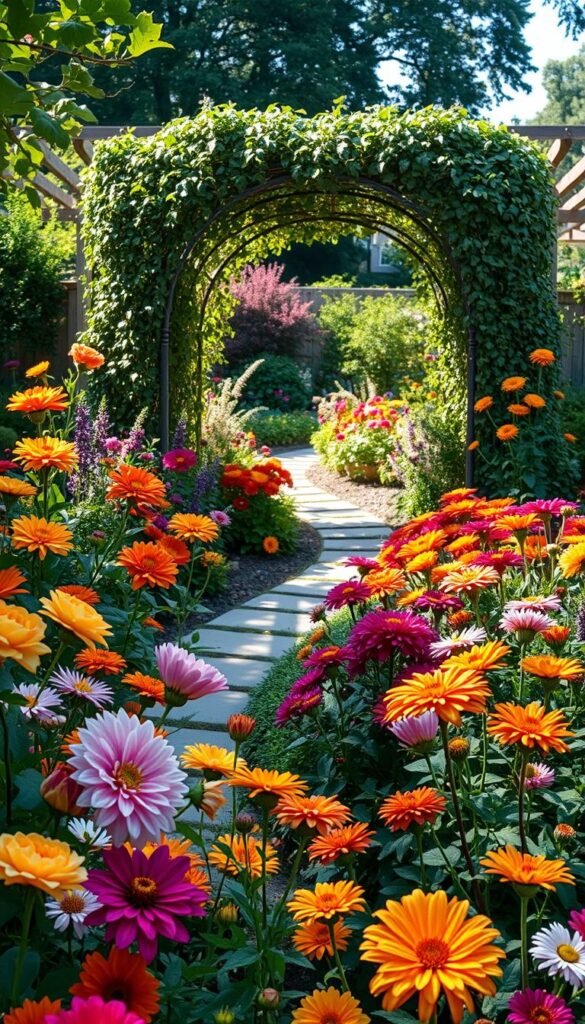
Your outdoor area becomes a personal oasis when you plan with purpose. Start by observing how sunlight dances across your yard at different times of day. Notice where shadows linger or where rainwater pools—these details shape your garden’s potential.
Imagining Your Ideal Outdoor Space
Think beyond spring tulips and summer roses. A truly vibrant space shines in December’s frost and September’s golden light. Ask yourself:
- Do you want a cozy nook for morning coffee or a lively zone for weekend gatherings?
- Should pathways guide visitors through bursts of color, or create quiet corners for reflection?
- How will evergreens and berry-filled shrubs maintain visual beauty when flowers fade?
Defining Your Garden Goals
Align your dreams with practical needs. A neighbor’s towering maple might inspire a shade-loving fern collection, while a south-facing slope could become a terraced wildflower meadow. Prioritize what matters most:
- Low-maintenance designs using native plants
- Bird-friendly habitats with winter food sources
- Strategic layouts that frame your best views from indoors
Remember, your garden should evolve with you. Start small—a single bed bursting with all-season interest proves what’s possible. As landscape designer Julie Moir Messery notes: “Great spaces feel discovered, not manufactured.” Your vision will grow clearer with every seed planted.
Planning Your Garden: Assessing Space, Soil, and Climate
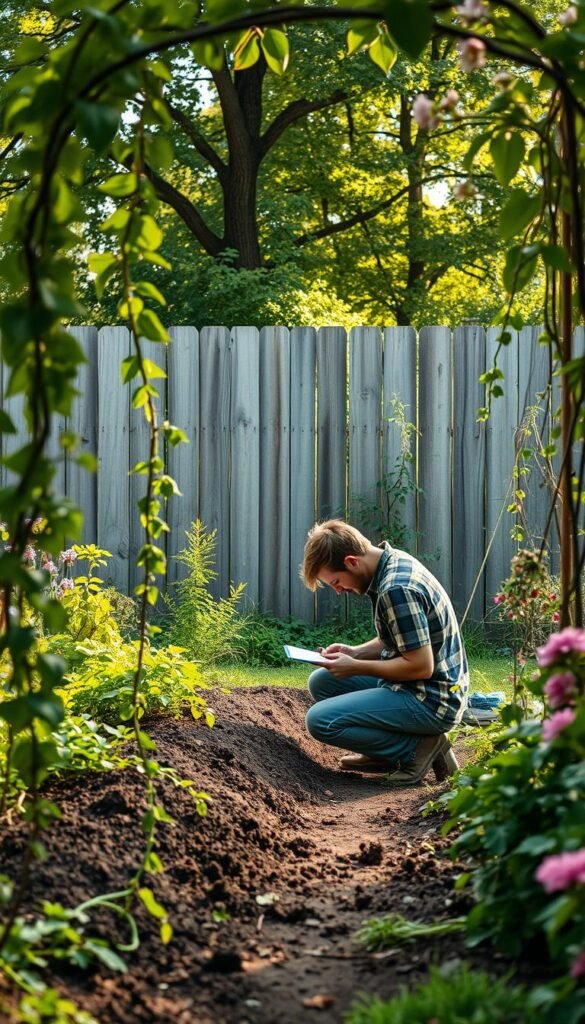
Before planting your first seed, understanding your garden’s unique environment sets the stage for success. Your plants’ health depends on three critical factors: local climate, soil composition, and sunlight patterns. Getting these right means fewer headaches and more blooms through every season.
Understanding Your USDA Zone
Your USDA hardiness zone acts like a plant survival guide. These zones, based on average winter lows, tell you which perennials thrive year after year. A quick zip code check on the USDA website reveals your zone—crucial for selecting trees and shrubs that withstand your coldest weather.
| Zone | Winter Temp Range | Thriving Plants |
|---|---|---|
| 5 | -20°F to -10°F | Coneflowers, Russian Sage |
| 6 | -10°F to 0°F | Hydrangeas, Boxwood |
| 7 | 0°F to 10°F | Camellias, Rosemary |
Mapping Sunlight and Microclimates
Track how shadows move across your yard in summer and winter. South-facing areas bake in full sun, while north sides stay cooler—perfect for shade-loving native plants. Microclimates near walls or slopes can be 5-10°F warmer, letting you push zone limits for delicate specimens.
Don’t guess—test your soil! A $15 kit reveals pH levels and nutrients. Acidic soils (below 6.0) suit blueberries, while alkaline earth (above 7.5) helps lavender thrive. Amend dense clay with compost for better drainage.
Note your area’s rain patterns—drought-prone regions need resilient plants. Sketch your space, marking trees and structures. This plan becomes your roadmap to a thriving landscape that adapts to local weather.
Designing a Garden Structure That Lasts All Year
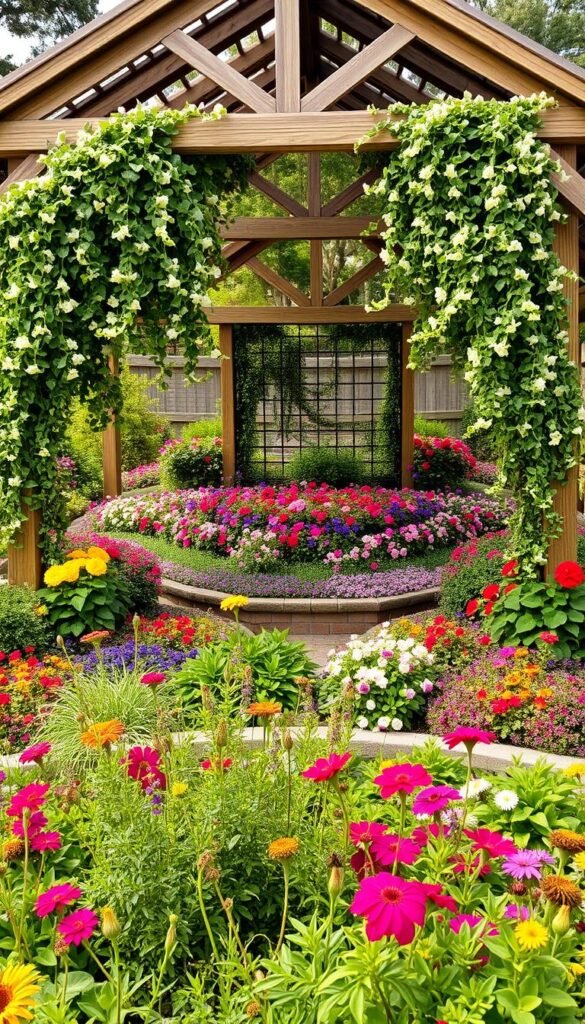
A garden’s structure works like a house’s foundation—it holds everything together when the “walls” of foliage fade. While summer blooms steal the show, winter reveals your space’s true design. Strategic layering ensures every season feels intentional, not accidental.
Building Layers That Work Together
Think of your space as having three tiers. Tall trees like redbuds or dogwoods form the canopy. Mid-height shrubs such as boxwood add middle structure. Low-growing sedum or creeping thyme anchor the base. This approach creates depth even when flowers aren’t blooming.
Balance evergreens with seasonal plants. Aim for 60% evergreens like holly or juniper to maintain winter interest. The rest can be deciduous varieties that offer spring blossoms or fall color. This mix keeps your garden lively year-round without looking bare.
| Layer Type | Plant Examples | Key Features |
|---|---|---|
| Canopy | Japanese Maple, Birch | Height, winter branch patterns |
| Middle | Hydrangea, Spirea | Texture, berry production |
| Base | Heuchera, Ajuga | Ground cover, foliage contrast |
Shape matters too. Pair upright grasses with mounding azaleas and trailing ivy. This combo adds movement and prevents flat, static layouts. Leave space for mature growth—crowded plants compete for light and nutrients.
For extra polish, add hardscapes that complement your gardening aesthetic. A stone bench under a trellis or curved gravel path guides the eye through your layered masterpiece, making every season feel curated.
Integrating Evergreens and Seasonal Flowers
A living tapestry of textures and hues emerges when you pair permanent greenery with fleeting floral displays. The secret lies in balancing steadfast evergreen shrubs with vibrant perennials that take turns shining through the seasons.
Architectural Greenery for Cold Months
Evergreen shrubs act as nature’s scaffolding, holding your garden’s shape when other plants retreat. Conifers like dwarf Alberta spruce offer needle-like texture, while broadleaf varieties such as mountain laurel provide glossy leaves. These woody heroes:
- Create privacy screens that work harder than fences
- Protect birds from harsh winds
- Showcase berries or colorful bark in winter’s muted landscape
| Evergreen Type | Example Varieties | Key Features | Seasonal Impact |
|---|---|---|---|
| Vertical | ‘Sky Pencil’ Holly | Compact growth, dark foliage | Year-round structure |
| Mounding | ‘Hudsonia’ Balsam Fir | Soft needles, dense habit | Winter snow capture |
| Variegated | ‘Golden Charm’ Cypress | Yellow-green foliage | Brightens shady corners |
Rotating Floral Highlights
Weave flowers between your shrubs like seasonal embroidery. Early bloomers like hellebores peek through snowmelt, while summer’s coneflowers attract pollinators. For cold-hardy plants that thrive in containers, consider winter pansies nestled near evergreen bases.
Remember: evergreens set the stage, but perennials deliver the drama. Pair ruby-red camellias with spring tulips, or contrast blue spruce needles with orange daylilies. This dance between permanent and temporary elements keeps your space dynamic yet grounded.
From Lawn to Lush: Backyard Flower Garden Ideas for Year-Round Color
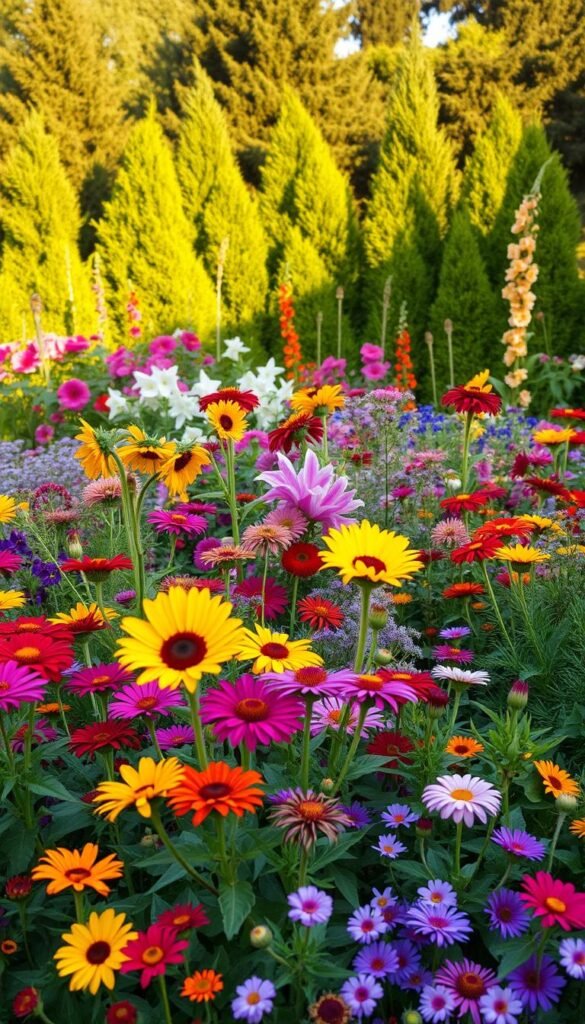
Curate a living masterpiece by pairing plants that shine in different seasons. Strategic combinations ensure your space stays vibrant through snowstorms and summer heatwaves. Let’s explore six star performers that deliver color when you need it most.
Camellias steal winter’s spotlight with rose-like blooms against glossy leaves. These evergreen shrubs thrive under tree canopies, offering February color when most flowers sleep. Pair them with early crocuses for a frost-defying duo.
| Plant | Peak Season | Key Feature | Companion Plants |
|---|---|---|---|
| Burning Bush | Fall | Fiery red foliage | Purple asters, ornamental grasses |
| Dogwood Tree | All Year | Four-season structure | Spring bulbs, hostas |
| Japanese Maple | Fall/Winter | Lacy crimson leaves | Fern varieties, heuchera |
| Holly Bush | Winter | Ruby berries | Snowdrops, winter jasmine |
The burning bush transforms into a scarlet torch each autumn. Underplant it with low-maintenance flowers like sedum for contrast. Dogwoods deliver year-round drama—spring blossoms give way to summer berries, then crimson fall leaves and sculptural winter branches.
Japanese maples add delicate texture with their filigree leaves. Their autumn fireworks pair beautifully with evergreen ferns. Holly bushes anchor winter landscapes, offering berries for birds and glossy leaves that catch snowfall like nature’s ornaments.
Stagger planting times so something always peaks. Early bulbs → summer perennials → fall foliage → winter berries. This rhythm keeps your garden alive with movement and surprise through every weather shift.
Seasonal Plant Selection and Planting Guides
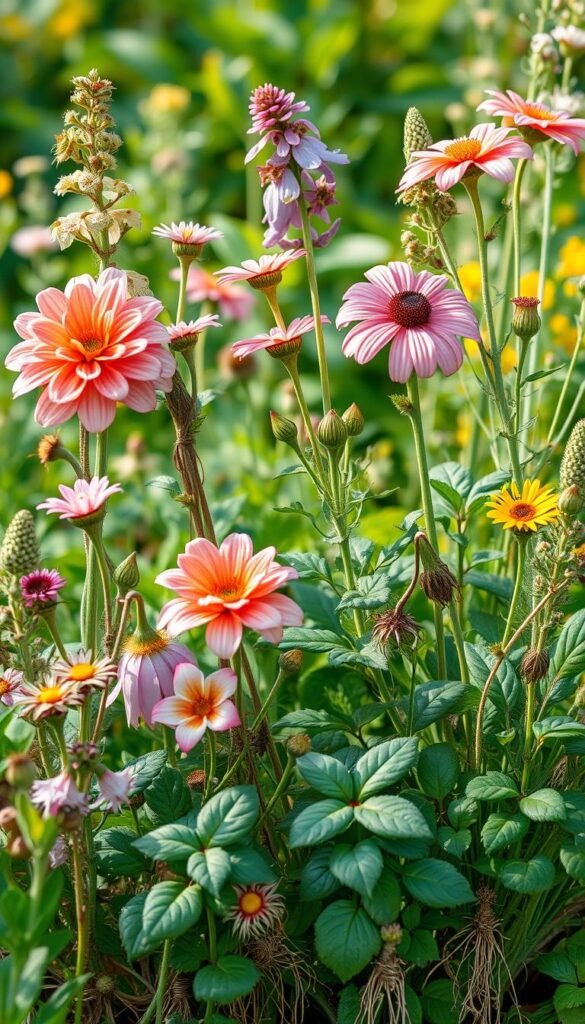
Timing is everything when crafting a garden that dazzles in every season. By aligning your plant choices with nature’s calendar, you’ll create waves of color that roll from spring thaw to winter frost. Let’s break down the best performers for each quarter of the year.
Spring and Summer Blooming Tips
Kick off the growing season with early risers. Snowdrops and crocus bulbs push through melting snow, while primroses add cheerful blooms in March. Follow these with bleeding hearts and hellebores—their intricate flowers thrive in cool spring air.
| Season | Plant Examples | Key Features |
|---|---|---|
| Spring | Crocus, Bleeding Heart | Cold-tolerant, early color |
| Summer | Coneflower, Zinnia | Heat-resistant, long bloom time |
When temperatures rise, switch to summer warriors. Black-eyed Susans and phlox thrive in full sun, blooming nonstop for 8-10 weeks. For container gardening strategies, try zinnias—their vibrant petals last until first frost.
Fall and Winter Foliage and Berries
As days shorten, asters and goldenrod take center stage. These late blooms feed migrating butterflies while sedums transition to rusty red hues. Don’t forget Mexican sunflowers—their orange explosions contrast beautifully with autumn skies.
| Season | Plant Examples | Winter Interest |
|---|---|---|
| Fall | Sedum, Aster | Seed heads for birds |
| Winter | Winterberry Holly | Ruby-red berries |
When frost arrives, let structure shine. Dogwood branches glow crimson against snow, while scarlet willow stems add vertical drama. Winterberry holly keeps its fruit all season, creating living bird feeders in your garden.
Creating a Color Coordination Strategy for Every Season
Transform your garden into a living painting by mastering color transitions through the seasons. Thoughtful combinations keep your space vibrant whether you’re enjoying spring’s first blooms or winter’s sculptural silhouettes.
Pairing Soft Hues with Bold Accents
Start with spring’s pastel palette. Combine bluebells with buttery daffodils, then layer in flowering cherry trees for soft pink highlights. These gentle colors create a welcoming atmosphere after winter’s dormancy.
Shift to summer’s fiery tones using complementary pairs. Orange daylilies pop against purple salvia, while red bee balm energizes green foliage backgrounds. Place bold combinations near seating areas where you’ll enjoy them up close.
| Season | Color Palette | Plant Examples | Design Tip |
|---|---|---|---|
| Spring | Pastels + White | Hyacinths, Dogwoods | Use as foundation for later accents |
| Summer | Warm Tones | Zinnias, Hibiscus | Group in clusters for visual impact |
| Fall | Earthy Reds/Golds | Maples, Sedum | Extend bloom time with evergreens |
| Winter | Textural Contrasts | Holly, Birch | Focus on bark patterns |
Autumn calls for nature’s own palette. Crimson maples pair beautifully with goldenrod’s yellow spikes. Add burgundy heuchera leaves for depth—their foliage lasts through frosts.
Winter landscapes shine through texture rather than flowers. Redtwig dogwood stems contrast with frosted juniper, while holly berries add festive pops. For year-round cohesion, try mixing vintage and modern elements in your design.
Remember: Cool-toned colors recede visually, while warm hues advance. Use this trick to make small spaces feel larger or highlight focal points. Your garden will flow seamlessly from one season to the next.
Enhancing Your Garden with Hardscapes and Non-Living Features
Every great garden needs strong bones. Hardscaping gives your space permanent structure through materials that shine when plants rest. These elements work like nature’s furniture—creating pathways, seating areas, and focal points that anchor your design.
Choosing Paving, Stone, and Water Elements
Stone pathways do more than guide footsteps. Crushed limestone softens edges over time, while flagstone patios reflect sunlight in summer and trap frost patterns in winter. For water features, try a birdbath with a gentle drip—it attracts thirsty pollinators without needing complex plumbing.
Building Arbors and Focal-Point Structures
Arbors wrapped in climbing roses frame views beautifully. A simple cedar pergola adds height for hanging plants or string lights. These features become living art when paired with weathered stone paths that blend seamlessly into your landscape.
Match materials to your home’s style—rustic timber suits farmhouses, while sleek concrete complements modern designs. Remember: hardscapes should whisper, not shout. Let them age gracefully, becoming part of your garden’s story.

